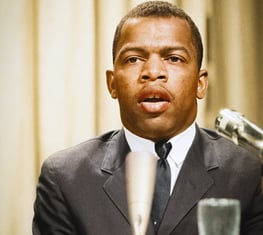One Person, One Vote: How Does the Electoral College Work?
When you cast your vote for President of the United States, you are not voting directly for a candidate. Instead, your vote — and the votes of everyone else in your state — directs the votes of the people who actually vote directly for President: presidential electors, otherwise known as members of the Electoral College.
This blog, and those that will follow, will explain how the Electoral College works, the history of the Electoral College — including its racist origins — and why it must be abolished.
Let’s begin by exploring who the electors of the Electoral College are, how they are selected, and how they vote for the President and vice president.
Who are Electors?
The presidential electors are 538 people selected from all 50 states and the District of Columbia to elect the President of the United States.
Stay Updated
Keep up with the upcoming election and other news with emails from LWV!
Members of the Electoral College vote on behalf of a given state for the candidate that wins that state’s popular vote. For example, if a certain candidate wins the popular vote in Nevada, Nevada’s presidential electors will vote for that candidate in the presidential election. To become President of the United States, a candidate must win 270 votes from these electors rather than the nation's popular vote.
Most electors tend to be party loyalists or elected officials. For example, former Secretary of State Hillary Clinton and former President Bill Clinton were electors for New York in the 2020 presidential election.
Each state receives at least three electors, one per representative and two for their senators. The District of Columbia is not a state but was given three electoral votes after the passage of the Twenty-Third Amendment. However, some states have more than three electors, such as Texas, which has 40, and Florida, which has 30. This is ostensibly because of the population disparities between different states but is one of many controversies around the Electoral College.
How Does the Electoral College Elect the President and Vice President?
The selection process for presidential electors varies between states. Generally, each party nominates a slate of electors during the party’s national convention. Then, when the average person casts their vote in a federal election, they’re voting for the electors who’ll cast the final votes for President and vice president.

Put another way: the Democrats and Republicans in your state will both pick a group of electors at their conventions. When it’s time to elect the president, let's say most people in your state vote for the Republican candidate. That means the Republican Party’s electors will now vote for President and vice president on behalf of your entire state.
Thus, when you vote in a presidential election, you indirectly cast your state’s vote for president by choosing a slate of electors who vote on behalf of the state for the candidate that won your state.
We know, it’s confusing.
Two states, Maine and Nebraska, apportion their electors by congressional district. For example, Maine has four electoral votes and two congressional districts. Maine’s second congressional district voted for Donald Trump in 2020, but its first congressional district voted for Joe Biden. Statewide, a majority of voters voted for Joe Biden. Thus, President Biden received three electoral votes, and then-President Trump got one electoral vote from Maine.
This method of allocating electoral votes means that, theoretically, a candidate could win a majority of the state’s electoral votes without winning the statewide vote. For example, in 2013, Pennsylvania Republicans proposed allocating the state’s electoral votes by congressional districts, which were gerrymandered to produce 13 Republican and five Democratic seats. Had this arrangement been implemented in 2012, then-President Obama could have received just eight of the state’s 20 electoral votes despite winning the statewide vote, a profoundly undemocratic outcome.
How do Electors Vote?
After being selected, the Presidential Electors gather on the first Monday after the second Wednesday of December at a place specified by state law, usually the state capitol, to cast their votes for President and vice president. For 2024, the electors will meet on December 16.
Electors cast two ballots, one for President and one for vice president. The votes are then tallied and reported on a certificate of ascertainment. Six copies of the certificate are made and sent to the following persons: one to the vice president of the United States, two to the archivist of the United States, two to the state’s secretary of state, and one to the United States District Court judge for the district where the electors meet.

In most cases, the slate of electors pledged to a candidate that wins a state will unanimously vote for that candidate and their nominee for vice president. However, there are occasional ‘faithless electors’ who refuse to vote for the candidate that won their state. This occurred in 2016 when multiple electors in several states refused to vote for either Donald Trump or Hillary Clinton.
The Supreme Court has unanimously upheld laws permitting states to penalize electors who do not vote for the winning candidate in their state and replace them with alternate electors.
How Does Congress Certify the Presidential Election?
Once each state’s electors vote, the certificates are sent to Congress. Then, as Article II Section 1 of the Constitution requires, the vice president, Senate, and House convene in the House chamber and count the electoral votes on January 6.
As stated by the Electoral Count Reform Act of 2022, the vice president’s role is strictly ministerial, meaning they cannot reject electoral votes from a state on their initiative. Previously, the vice president’s role was unclear, a fact exploited by the plotters of January 6, who sought to have Mike Pence reject electoral votes and keep then-President Trump in power unilaterally.
The candidate who receives a majority, 270 electoral votes, is elected President. The totals are entered into the journal of the House and Senate and announced by the vice president.
In the event that no candidate receives a majority, the House of Representatives chooses the President, with each state having one vote, to be determined by a majority of that state’s House delegation.
Who Can Object to Electoral Votes?
Congress can object to certification of a state’s electoral votes. These may only be made if one-fifth of the duly elected and sworn memberships of the House and Senate, 87 representatives and 20 senators, respectively, object in writing.
The Electoral Count Reform Act of 2022 only permits two types of objections:
- The electors were not lawfully certified with a certificate of ascertainment; or
- The votes of an elector or electors were not regularly given.
For an objection to be sustained, both houses must vote separately and agree upon the objection. Debate on an objection to a state’s electoral votes may not exceed two hours in each house, with allotted time being controlled by the majority and minority leaders.

After the election is certified, the President and vice president are inaugurated on January 20.
The Problem with the Electoral College
The Electoral College system means that our president and vice president are not elected based on the people’s majority vote but rather on a convoluted system of electors. This has significant implications. The American people, as a whole, are not choosing the President; instead, the states, as represented by their electors, are selecting them.
In short, the Electoral College allows someone to become President by having the right combination of states, even without a majority of the popular vote. Most recently, this occurred in 2016. Presidents were also elected without winning the popular vote in 2000, 1888, 1876, and 1824.
This system can make people feel their vote doesn’t matter and may lead them to refrain from casting a ballot. Doing so can have a major negative impact.
To start, it can silence the voices of countless voters when it comes to electing who will lead their nation.
Get out the vote in your community by joining your local League!
On top of that, it has a major impact on local officers. During each presidential election, dozens or hundreds of congressional, state, and local offices are on the ballot. If voters are disheartened about casting their ballot because they feel it won’t change who becomes president, this can have severe ramifications for all those other elections.
For example, if you lived in a state like Montana or Missouri in 2020, which were safely Republican on the presidential level, several judicial elections still decided the makeup of the state supreme courts. The jurists up for election would hear vital cases on voting rights and abortion, among others, which would affect the lives of millions. Voters who stayed home because they didn’t feel their vote mattered for the presidential race missed an opportunity to have a say in who was elected to those crucial jurist positions.
Just because some states’ electoral votes are almost guaranteed to go to a certain presidential candidate doesn’t mean your vote doesn’t matter. For the dozens of candidates and initiatives on your ballots, it can make a life-changing difference.
The modern Electoral College process largely functions as a formality, existing to confirm the votes of the people of each state for President. Political parties strictly control the selection of their respective electors, and states bind these persons to vote per their voters’ will. Therefore, the Electoral College has no independent power or role in electing a President. It is a device to tally up the states’ votes for president.
However, while the Electoral Count Reform Act of 2022 closed some loopholes that the January 6 plot tried to exploit, the fundamental structure of the Electoral College creates perverse incentives and remains a danger to American democracy. This risk, along with the Electoral College’s racist origins, will be explored in further installments of this series.
The Latest from the League
The Electoral College is often not a well-understood entity. I want to highlight some of the history and shortcomings of this process and offer some possible solutions to replacing this flawed system for the good of the nation and the health of our democracy.
When redistricting is done fairly, each person’s vote is equal to every other person’s because their districts are drawn in ways that accurately represent the voting power of the people within them.
When redistricting is done unfairly, however, and maps are created to favor one party (partisan gerrymandering) or with race as the predominant factor (racial gerrymandering), voters in certain districts are given more power than others.
Congress attached legislation to update how votes are counted and cast by the Electoral College to the omnibus appropriations bill that passed in the final days of the 117th Congress.
Current bipartisan proposals would clarify existing ambiguities in the legislation around the role of the Vice President and the certification of electors and offer transparency around how electors are appointed.
Sign Up For Email
Keep up with the League. Receive emails to your inbox!
Donate to support our work
to empower voters and defend democracy.





